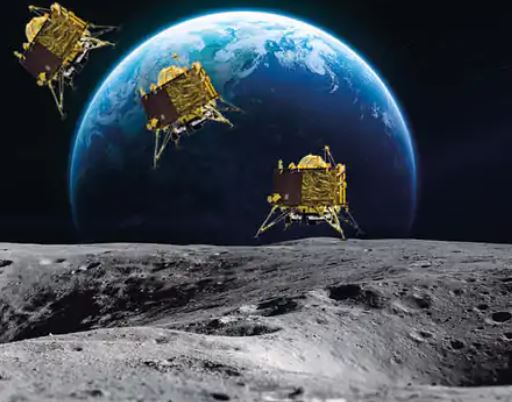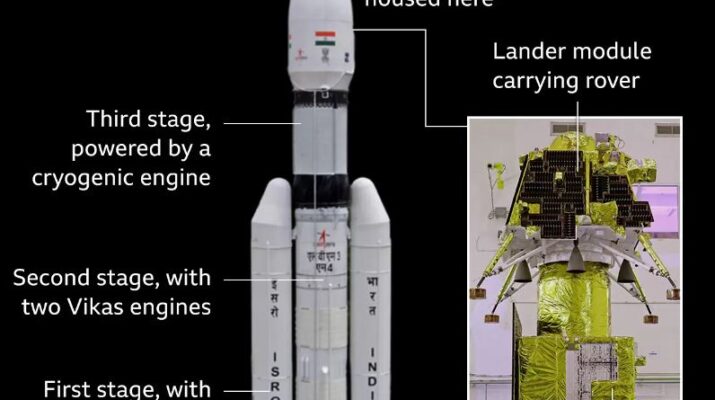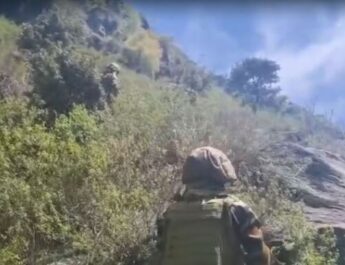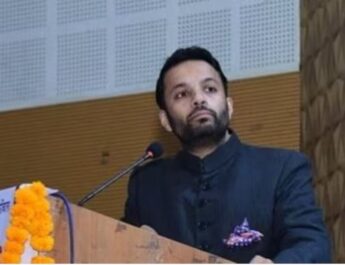Chandrayaan-3: Vikram lander successfully lands on the Moon; India becomes 4th country to make a soft landing on lunar surface. It was launched on July 14 at 3.35 a.m. from Sriharikota in Andhra Pradesh. After landing, it will write a new history by covering a distance of 3.84 lakh km in 41 days.
The powered descent of the Lander Module (LM) of the Indian Space Research Organisation’s (ISRO) third lunar mission Chandrayaan-3, launched on July 14, has begun. The LM is propelling toward the moon’s surface in the intended trajectory, the space organization said.
Vikram Lander and Pragyan will photograph each other and send it to Earth. If India is successful in this mission, it will be the first country to land on the South Pole of the Moon.
50 scientists lost their night and the atmosphere of excitement and anxiety in the command center
In the Mission Operation Complex (MOX) of ISRO’s Telemetry and Command Center (ISTRAC) in Bengaluru, more than 50 scientists spent the whole night analyzing the data received from Chandrayaan-3 on computers. They are sending inputs to the lander so that every scope for making wrong decisions at the time of landing is over.
Everyone is talking in sign language. There is a mixed atmosphere of excitement and restlessness in the command center. ISRO scientists are receiving data from the ISRO Telemetry Tracking and Command Network (ISTRAC) in Bengaluru and the Indian Deep Space Network at Byalalu village, as well as real-time data from the European Space Agency’s station in Germany, Australia, and NASA’s Deep Space Network Taking verification.
Chandrayaan-3 will land even if Vikram’s two engines fail
ISRO Chairman S Somnath had said on August 9 about Vikram’s landing- ‘If everything fails, if all sensors fail, nothing works, still it (Vikram) will land, provided algorithms work properly. We have also ensured that even if two engines of Vikram fail this time, it will still be capable of landing.
He said that the last 19 minutes of Chandrayaan-3 will be breathtaking. The speed at the start of landing will be 6,048 km/h. It will be less than 10 km/h while touching the moon. The landing site will not be selected from the ISRO command center. The lander will select the location from its computer.
Chandrayaan-3 will have four phases of landing
- Rough Breaking Phase
- At this time the lander will be 750 Km away from the landing site and the speed will be 1.6 Km/sec.
- This phase will last for 690 seconds. During this, all the sensors of Vikram will be calibrated.
- In 690 seconds the horizontal speed will be 358 m/sec and the downward speed will be 61 m/sec.
- Altitude Hold Phase
- Vikram will take photographs of the lunar surface and compare them with the already existing photographs.
- At the time of Chandrayaan-2, this phase was of 38 seconds, now it has been reduced to 10 seconds.
- During this, the horizontal velocity will be 336 m/s and the vertical velocity will be 59 m/s.
- Fine Breaking Phase
- This phase will last for 175 seconds, in which the speed will come down to 0.
- The position of the lander will be completely vertical.
- The height from the surface will be between 800 m to 1300 m.
- Vikram’s sensors will be activated and height will be measured.
- Photos will be taken again and compared.
- Terminal Descent Phase
- In the next 131 seconds, the lander will come 150 meters above the surface.
- The Hazard Detection Camera mounted on the lander will capture images of the surface.
- The hazard detection camera fitted on Vikram will do a go-no-go test run.
- If everything is correct then Vikram will land on the moon in 73 seconds.
- If there is a no-go condition, then it will stop after going 150 meters ahead.
- Will check the surface again and if everything is correct then will land.
What will happen after landing?
- Vikram will be on and will communicate after the dust settles.
- Then the ramp will open and Pragyan Rover will come from the ramp to the lunar surface.
- The wheels will leave an imprint of the Ashoka Pillar and the ISRO logo on the lunar soil.
- Vikram Lander will take photos of Pragyan and Pragyan of Vikram.
- These photos will be sent to the Earth.





